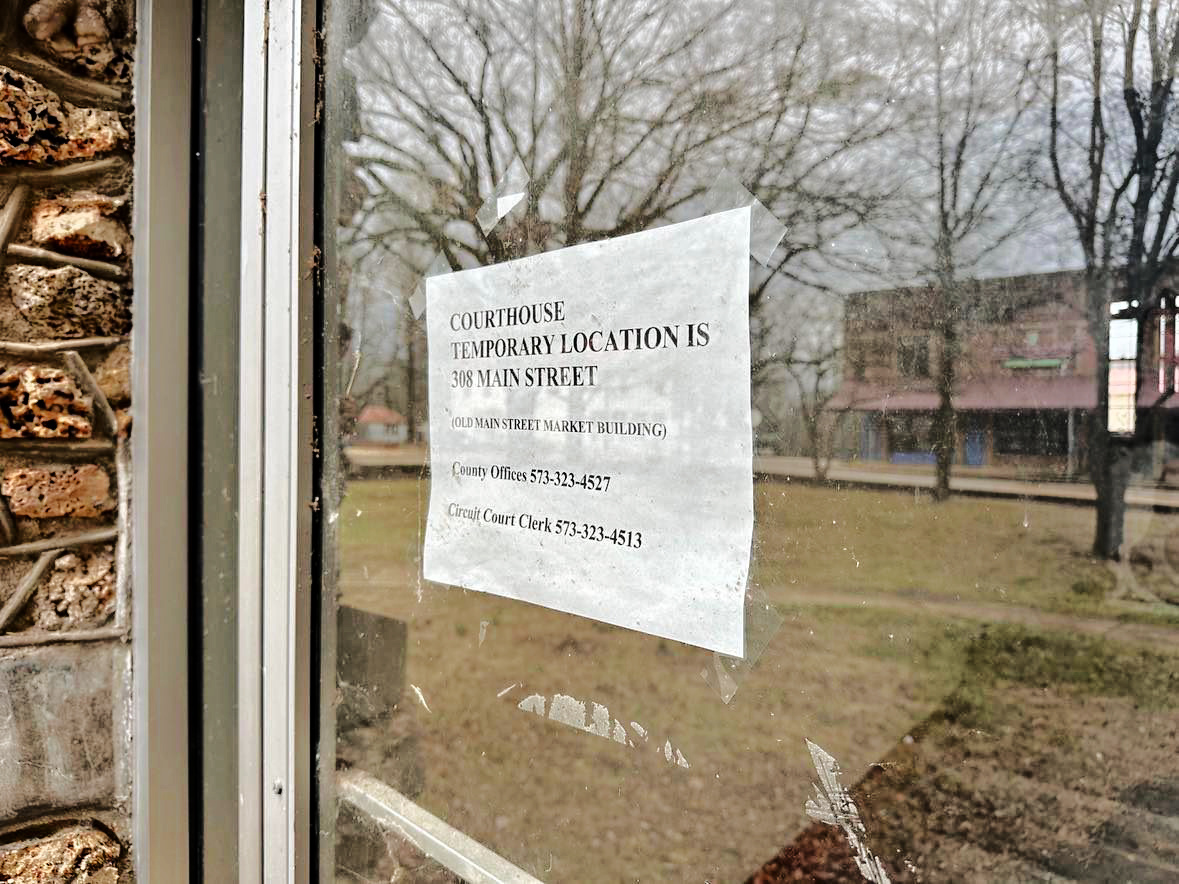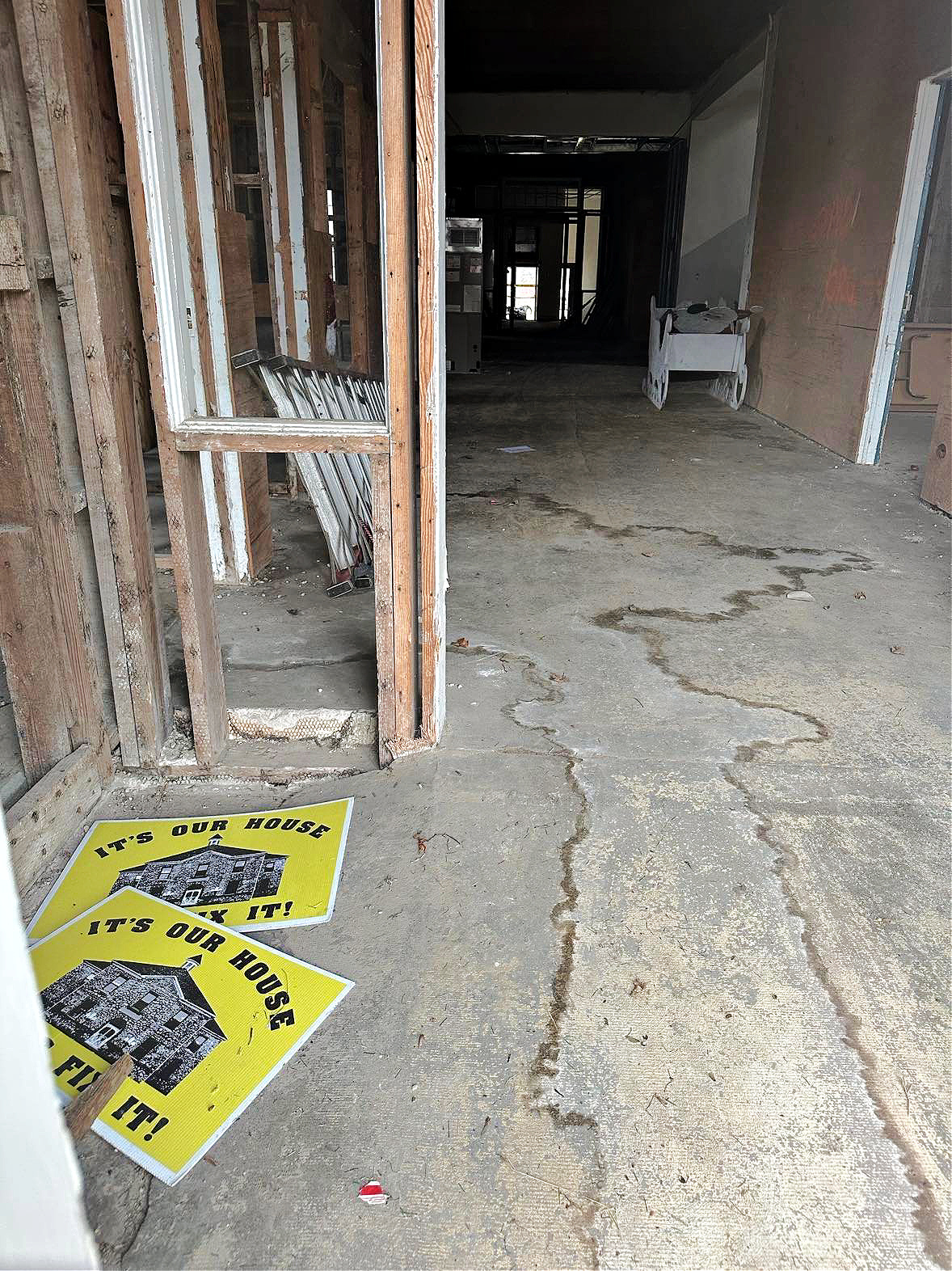This story is published in partnership with Ozarks Alive, a cultural preservation project led by Kaitlyn McConnell.

VAN BUREN - Nearly a century ago, a “record crowd” gathered at the Carter County Courthouse in Van Buren to decide who among them was the top old-time fiddler. Bows cut the air as they fought it out, leaving Albert Gregory as the winner. With the better part of 185 votes, he went on to compete against fiddlers from other counties for the chance to be considered an even better best.
The fiddle strains of that long-ago night have long disappeared into the past, but the place where they gathered remained at the heart of the community — the Carter County Courthouse, a one-of-a-kind, cobbled-rock building of which portions date to 1871.
For more than 150 years, it has remained a place to gather and keep history in the present. Yet while its past is cemented in hearts, minds and history books, its future is in need of help.
Historic flooding of the Current River in April 2017 brought devastation to the building, causing county offices to relocate. Due to terms with FEMA, which paid the county $8.6 million to help construct a new justice center on higher ground, those offices will never move back into the aged building.
That fact has brought division and strong feelings, locals say. Yet at least some voices share common sentiment: It’s time to move forward and save the building, even if it’s for a new purpose.
“We have a vision for what we want it to look like,” says Rebeca Pacheco, president of the Friends of the Carter County Courthouse, a nonprofit group working to raise money to restore the building. “That vision is a welcome center for the region. We have a lot of support for that; a lot of community support, a lot of politic al support. But the funding that we need is a large amount of money.”
The challenge: a nearly $1.5-million price tag, which is the estimate given to make necessary repairs.
Why is the building significant?
Even in its younger years, the courthouse was a source of pride for the community. Newspapers present moments in the early 1900s when there was talk of replacing it. In 1927, a Kansas City Star reporter’s impression of local sentiment was that folks felt it should go. That didn’t happen.
“At Van Buren you find a banner flung across the front entrance of the county capital, advertising the headquarters of the Chamber of Commerce, and are told that local pride is so sensitive about the old courthouse that a bond issue for a new building will probably be voted in 1927,” the reporter wrote. “Which, in a way, would be a pity. For a skillful architect, with just a touch or two, could relieve somewhat the present starkness of the design. Then, with the venerable elms in the yard to help him, and the newly dedicated soldier statue to heighten the illusion, this Ozark square would look so much like a village green of New England that all tourists would coo in delight.”
Wait — white walls? Where were the stones?
They were still in the Ozarks hills. It wasn't until the 1930s when the WPA installed them on the building, part of a significant expansion project at the courthouse — which had once again been considered for replacement.

Instead, it was shared in the Springfield paper in August 1935 that the “WPA will remodel the Carter county courthouse at Van Buren and to make the building more attractive.”
Work began by November, during which county offices moved to a nearby filling station. A dedication ceremony was held the following August, promoted beneath a photo of the building in the Current Local newspaper:
“It is a two-story structure built of native stone, the construction work having been done solely by local residents. The beauty of the rock work especially has drawn the attention of builders and contractors from all over the state, which speaks well for the ability of the local workmen and supervisors.
“For its amount of population, Carter County may now boast of one of the finest courthouses in the state and a permanent monument to the progressive spirit of its people.”

It should be noted that some newspapers refer to the “new” Carter County courthouse. That does not mean a new building was errected; the changes, however, were so significant that it felt like a new place – and today, a special one.
“The Carter County Courthouse is the only still-standing cobblestone courthouse left in Missouri,” says Riley Price, executive director of Missouri Preservation. “I feel like it is such an iconic building for that region.”
The St. Louis-based nonprofit preservation group felt so strongly about the landmark that it included it on the 2019 Places in Peril list. The list annually recognizes sites across the state that are historically significant and at risk.

“Our tagline is ‘preserving place and community for future generations,’” Price says. “We save these places, because they tell the story of our past, they teach our communities what we were, it gives us a sense of identity.”
In 2022, one of Missouri Preservation’s board members also helped submit a successful application for the National Register of Historic Places. Yet its significance goes beyond words on an application for people like Liz Orr, whose family goes back to the start of Carter County and is involved in the courthouse's restoration efforts.
“My personal connection is I'm a Carter descendant – and that's our courthouse,” says Orr. “This is our town and this is our county. I'm very passionate about it. Our roots run deep.”
The flood that changed everything
No one knew it at the time, but a day in late April 2017 was the last of the rock building's life as a seat of governement. Flooding was in the forecast, but no expectation that it would bring significant damage.
“When we got the call that the river was coming up, they told me it was going to crest at like 34 feet. So we went in, and we knew where the 34 feet would hit,” says Donald Black, who was the presiding commissioner of Carter County at the time. “We went in and put all the records up on tables, just in case it got to that level.”
In retrospect, Black says that prediction would have been about four inches of water in the courthouse.
A few hours later, indications proved incorrect: The courthouse was soon flooded by about six feet, drowning paper records, equipment and infrastructure. It was only one point of crushing crisis for the county where homes and infrastructure were destroyed – but thankfully, not people.
“We were fortunate we didn't lose any lives on this deal,” says Black. “We were blessed that way.”
The flood’s aftermath
Amid boat searches and rescues, it took hours for the nearby river water to recede from the courthouse. While some things were able to be salvaged – including records which, on the guidance of the Missouri Secretary of State’s office, were frozen – the aging government building was left with devastating issues.
Ultimately, the main floor of the structure had to be gutted and county offices moved out to a temporary location.
“It was stucco, so we had to cut that all out. Once we got in it, it had so much termite damage in the building that we're lucky it was even standing,” says Black. “If it wasn't for the rock and the mortar, it probably wouldn't have been standing.”

In the following months, discussion went back and forth about the future of the courthouse. The challenge was exacerbated by the fact, Black says, that the sparsely populated county didn’t have insurance or money in its coffers to cover repairs.
“That's what puts us in a bad spot – because the federal government owns so much land there,” he says. “If all that land was private land, Carter County would have monies to do things, but I think 60-some percent is owned by federal (agencies). That puts it on the citizens to make up the difference for all that and it's really tough.”
The debate caused significant controversy in the small community. So much tension, in fact, that some individuals hesitate to even talk about it today.
The bottom line: County leaders accepted a deal from FEMA for $8.6 million towards the construction of a new justice center. The funding, however, carried a catch: No offices that were formerly in the courthouse could go back in the building due to having flooded and the chance it might happen again.
Down the road from the former courthouse stands that new facility – high atop a hill and far from the river’s waters. Ultimately, the reality and associated tensions may have been the cause of Black’s end as commissioner. He lost his bid for reelection in 2018.
“There was a group of people that started saying that I was wanting to tear the building down and … I was making a deal with FEMA and they would tear the building down,” says Black. “That never was true.
“I am 100% on redoing the courthouse. I always have been, always will be. But there's decisions to be made. That you have to make based on the facts that's going on at the moment.”
Looking forward to a new chapter

Even though the cobblestone courthouse – “The courthouse is always going to be the courthouse,” as Orr puts it – won’t house government going forward, its work isn’t done.
“We have a new justice center. But the focus now is to get the courthouse up and going, and we’re also working on revitalizing the downtown,” says Orr, who has memories in her mind's eye of what Van Buren used to be.
“When I was a kid, we spent so much time on the river and downtown. It was a bustling community. We still have functions downtown. People love to come downtown. You know there are a lot of people in the community that still have the vision.”
Like Pacheco, Orr is involved with Friends of the Carter County Courthouse, which has raised around $16,000 for the project to date. While it's a far piece from where they need to be, work still continues, as do gatherings on the lawn.
“We’ve partnered with the Van Buren Chamber of Commerce; they want to move their operations into the building,” says Pacheco. “The University of Missouri Extension for Carter County wants to move their office into the building. We have letters of intent from local artists and businesses that would like to move into the upstairs. So we think that we would be able to, with the rentals, generate enough money to at least break even to operate the building.”
The friends group is currently awaiting news from the Missouri Department of Economic Development on grants powered by ARPA funding it has applied to receive. If successful, the Tourism Grant and Community Develpment Grant could cover around 50% of the project, requiring the other half to be matched.
Even though either reality presents a significant amount to raise, Pacheco says they are committed to the project.
“We haven't given up. The flood was in 2017. We're in 2023. I know there's a lot of questions from people about what is happening,” she says. “I think I really just want people to know that we're still working on it, and exploring every avenue. There's a lot of support; we're not going to give up until we find a way to restore the building.”
Donations may be made to Friends of Carter County Courthouse at First Midwest Bank, where a bank account has been established. They may also be mailed to the friends group at P.O. Box 116 Van Buren, MO 63965.

